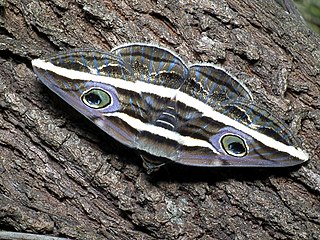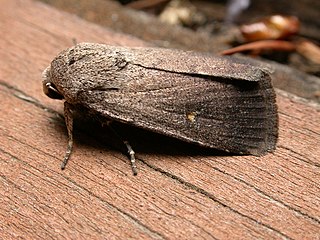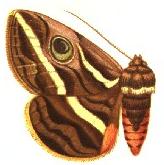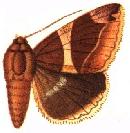
Copromorphidae, the "tropical fruitworm moths", is a family of insects in the lepidopteran order. These moths have broad, rounded forewings, and well-camouflaged scale patterns. Unlike Carposinidae the mouthparts include "labial palps" with the second rather than third segment the longest. With other unusual structural characteristics of the caterpillar and adult, it could represent the sister lineage of all other extant members of this superfamily. The genus Sisyroxena from Madagascar is also notable for its unusual venation and wing scale sockets.

Hypatima is a genus of the twirler moth family (Gelechiidae). Among these, it belongs to a distinct lineage, which is variously treated as tribe Chelariini in subfamilies Dichomeridinae, Gelechiinae, or even Pexicopiinae, and historically was considered a subfamily in its own right, Chelariinae. Of this lineage, Hypatima – under its junior synonym Chelaria – is the type genus. This genus has numerous species, but its exact limits are not quite clear. This genus occurs mainly in the Southern Hemisphere, though one of the better-known species is the only member of this genus native to Europe, the lobster-clawed moth.

Donuca is a genus of moths of the family Noctuidae. The genus was erected by Francis Walker in 1865.
Habrophyes is a monotypic moth genus of the family Noctuidae. Its only species, Habrophyes xuthosoma, is found in Australia where it is found in the Northern Territory and Queensland. Both the genus and species were first described by Alfred Jefferis Turner, the genus in 1920 and the species 11 years earlier in 1909.

Heraclia is a genus of moths of the family Noctuidae. The genus was erected by Jacob Hübner in 1820.

Proteuxoa is a genus of moths of the family Noctuidae. The genus was erected by George Hampson in 1903.
Bocula odontosema is a moth of the family Erebidae first described by Alfred Jefferis Turner in 1909. It is found in the Australian state of Queensland and in New Guinea.

Donuca castalia, the brown white banded noctuid, is a moth of the family Noctuidae. The species was first described by Johan Christian Fabricius in 1775. It is found in Queensland.

Donuca rubropicta is a species of moth of the family Noctuidae first described by Arthur Gardiner Butler in 1874. It is found in Australia in south-eastern Queensland and north-east New South Wales.

Donuca orbigera is a species of moth of the family Noctuidae first described by Achille Guenée in 1852. It is found in the northern half of Australia.

Bastilla dicoela is a moth of the family Noctuidae first described by Alfred Jefferis Turner in 1909. It is found in the Australian state of Queensland.

The Depressariinae – sometimes spelled "Depressiinae" in error – are a subfamily of moths in the superfamily Gelechioidea. Like their relatives therein, their exact relationships are not yet very well resolved. It has been considered part of family Elachistidae sensu lato or included in an expanded Oecophoridae. In modern classifications they are treated as the distinct gelechioid family Depressariidae.

Tinea is a genus of the fungus moth family, Tineidae. Therein, it belongs to the subfamily Tineinae. As evident by its name, it is the type genus of its subfamily and family. Established as one of the first subgroups of "Phalaena", it used to contain many species of Tineidae that are nowadays placed in other genera, as well as a few moths nowadays placed elsewhere.

Lyonetia is a genus of moths in the family Lyonetiidae.
Synanthedon xanthopyga is a moth of the family Sesiidae. It is known from western Africa.

Xyloryctidae is a family of moths contained within the superfamily Gelechioidea described by Edward Meyrick in 1890. Most genera are found in the Indo-Australian region. While many of these moths are tiny, some members of the family grow to a wingspan of up to 66 mm, making them giants among the micromoths.

Eretmocera is a genus of moths in the family Scythrididae.











